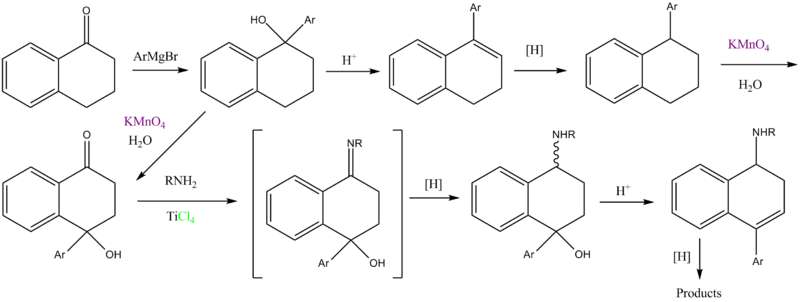Tametraline
|
|
This article has an unclear citation style. (February 2014) (Learn how and when to remove this template message) |
 |
|
| Clinical data | |
|---|---|
| ATC code | none |
| Identifiers | |
|
|
| CAS Number | 52760-47-1 |
| PubChem (CID) | 104180 |
| ChemSpider | 143316 |
| UNII | 440C8K5Y5K |
| Chemical and physical data | |
| Formula | C17H19N |
| Molar mass | 237.339 g/mol |
| 3D model (Jmol) | Interactive image |
|
|
|
|
| |
|
Tametraline (CP-24,441) is the parent of a series of chemical compounds investigated at Pfizer that eventually led to the development of sertraline (CP-51,974-1).[1]
Sertraline has been called "3,4-dichloro-tametraline". This is correct but it is an oversimplification in the sense that sertraline is the S,S-isomer whereas tametraline is the 1R,4S-stereoisomer.
1R-Methylamino-4S-phenyl-tetralin is a potent inhibitor of norepinephrine uptake in rat brain synaptosomes,[2] reverses reserpine induced hypothermia in mice, and blocks uptake of 3H into rat heart.[3]
Tametraline is a norepinephrine-dopamine reuptake inhibitor.[4]
Indatraline is an indanamine homolog of tetralin-based tametraline, although in the case of indatraline the product is pm-dichlorinated.
Contents
Chemistry[edit]
Two routes have been previously described,[5] one for aryl moieties containing electron withdrawing groups, and one for electron donating groups:
Sarges, R. . (1975). "Synthesis of phenyl-substituted 1-aminotetralines". The Journal of Organic Chemistry. 40 (9): 1216–1224. doi:10.1021/jo00897a008.
"As expected, Friedel-Crafts cyclization of the diarylbutyric acid derivatives # to the most reactive ring was observed with little or none of the alternative isomer being detected."
"The KMnO4 oxidation of the 1-aryl-tetralins # was observed to give 4-hydroxy-4-aryltetralones # instead of the expected tetralone # previously reported.[5] As a result of this finding, direct oxidation of Grignard reaction product # was attempted and found to be a more efficient route."
See also: U.S. Patent 4,045,488 (and refs therein: doi:10.1021/ja01193a020 doi:10.1021/ja01183a058 doi:10.1021/ja01157a130 doi:10.1021/ja01635a052)
cis-/trans-Ratio[edit]
In the case of 3,4-dichloro product, approximately 50:50 cis-/trans- ratio was achieved, according to the reference.[4]
CAN radical induced dimerization of styrene[edit]
"A facile one-pot synthesis of 1-amino-4-aryl-tetralin derivatives by the CAN-induced (see also: CAN) cyclodimerization of various styrenes in acetonitrile and acrylonitrile is described." [1] [2] doi:10.1021/ol0257934

Structure-activity relationship[edit]
Certain aromatic substitutients have a potentiating effect (e.g., p-Br), whereas others negate the compound's intrinsic activity.
It is not right to think of the dimethyl analogs as a "prodrug" to the monomethylated drugs (cf. indatraline, "31,345"), but it is correct that it is a "latentiated" form of the drug. This word is from the salsalate page. This was the reason why sertraline was made only as monomethylated because apparently according to the orders the 1° amine is inactive therefore the drug would have a shorter duration of activity.
Enantiopurified trans- and cis-aminotetraline derivatives[edit]

| Enantiopurified 4-aryl-aminotetralins IC50 (μM) | |||||||
| Stereo | X | Y | NE | DA | 5-HT | ||
| RS | H | H | 0.018 | 0.15 | 0.84 | ||
| SR | H | H | 0.37 | 1.40 | 14.00 | ||
| RS | Cl | H | 0.019 | 0.052 | 0.084 | ||
| SR | Cl | H | 0.46 | 1.40 | 3.50 | ||
| RS | Cl | Cl | 0.01 | 0.044 | 0.039 | ||
| SR | Cl | Cl | 0.044 | 0.27 | 0.47 | ||
| SS | Cl | Cl | 1.20 | 1.30 | 0.06 | ||
| RR | Cl | Cl | 0.30 | 0.32 | 0.46 | ||
Interestingly, (±)-sertraline is not entirely SERT selective until it has been resolved into the S,S-enantiomer.
In terms of the trans- isomers there is relatively marked separation in the activity between the R,S- and S,R-enantiomers. This stands in contrast to what has been observed in the homologous indamine class where both of the trans- enantiomers possessed significant TRI activity at all three of the monoamine transporters.
Racemic cis- and trans-aminotetraline derivatives[edit]
|
|
||||||||||||||||||||||||||||||||||||||||||||||||||||||||||||||||||||||||||||||||||||||||||||||||||||||||||||||||||||||||||||||||||||||||||||||||||||||||||||||||||||||||||||||||||||||||||||||
The primary amines are claimed to completely lack any affinity for the transporters.
See also[edit]
| Dimefadane[7] | Indriline[8][9] |
|---|---|
 |
 |
- CP-24,441 (1R,4S-N-methyl-4-phenyl-1,2,3,4-tetrahydro-1-naphthylamine)
- CP-39,332 (N-methyl-4-phenyl-1,2,3,4-tetrahydro-2-naphthylamine)
- Cyproheptadine [4-(5H-dibenz-[a,d]cyclohepten-5-ylidine)-1-methylpiperidine]
- Dasotraline
- Desmethylsertraline
- EXP-561 (1-amino-4-phenylbicyclo[2.2.2]octane)
- JNJ-7925476
- Lometraline
- Nefopam
- Sertraline
Sepracor has tried to patent the trans- dichloro analog U.S. Patent 7,105,699.
External links[edit]
- http://www.healyprozac.com/Book/Introduction.doc
- http://www.zoominfo.com/people/Koe_Ken_594418650.aspx
During his 40 years at Pfizer, Koe authored more than 100 articles and papers. ... Koe learned to review previous studies and to build on findings that had failed to lead to successful products. In his early work with serotonin, for example, he studied the chemical tametraline, which proved ineffective as an anti-depressant.
Tests showed the chemical functioned more as a stimulant, a use Pfizer was not interested in pursuing. Although his research had failed to yield the desired result, Koe was convinced that the development of a viable anti-depressant was within reach.
References[edit]
- ^ Koe, BK; Weissman, A; Welch, WM; Browne, RG (September 1983). "Sertraline, 1S,4S-N-Methyl-4-(3,4-Dichlorophenyl)-1,2,3,4-Tetrahydro-1-Naphthylamine, a New Uptake Inhibitor with Selectivity for Serotonin" (PDF). The Journal of Pharmacology and Experimental Therapeutics. 226 (3): 686–700. PMID 6310078. Retrieved 10 August 2016.
- ^ Koe, BK (December 1976). "Molecular Geometry of Inhibitors of the Uptake of Catecholamines and Serotonin in Synaptosomal Preparations of Rat Brain". The Journal of Pharmacology and Experimental Therapeutics. 199 (3): 649–61. PMID 994022.
- ^ Sarges, R; Koe, BK; Weissman, A; Schaefer, JP (December 1974). "Blockade of Heart 3H-Norepinephrine Up-take by 4-Phenyl-1-Aminotetralines: Implications for the Active Conformation of Imipramine-Like Drugs". The Journal of Pharmacology and Experimental Therapeutics. 191 (3): 393–402. PMID 4427286.
- ^ a b Welch, WM; Kraska, AR; Sarges, R; Koe, BK (November 1984). "Nontricyclic Antidepressant Agents Derived from cis- and trans-1-Amino-4-aryltetralins". Journal of Medicinal Chemistry. 27 (11): 1508–15. doi:10.1021/jm00377a021. PMID 6492080.
- ^ a b Sarges, RA (May 1975). "Synthesis of Phenyl-Substituted 1-Aminotetralines". The Journal of Organic Chemistry. 40 (9): 1216–24. doi:10.1021/jo00897a008.
- ^ Peng, XQ; Xi, ZX; Li, X; Spiller, K; Li, J; Chun, L; Wu, KM; Froimowitz, M; Gardner, EL (December 2010). "Is Slow-Onset Long-Acting Monoamine Transport Blockade to Cocaine as Methadone is to Heroin? Implication for Anti-Addiction Medications". Neuropsychopharmacology: Official Publication of the American College of Neuropsychopharmacology. 35 (13): 2564–78. doi:10.1038/npp.2010.133. PMC 2978747
 . PMID 20827272.
. PMID 20827272. - ^ Barltrop, J. A.; Acheson, R. M.; Philpott, P. G.; MacPhee, K. E.; Hunt, J. S. (1956). "570. Compounds of potential pharmacological interest. Part IV. Aryl and alkyl derivatives of 1-aminoindane". Journal of the Chemical Society (Resumed): 2928. doi:10.1039/JR9560002928.
- ^ A. Kandel and P, M. Lish, BE 667739 (1966).
- ^ eidem U.S. Patent 3,360,435

